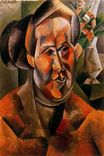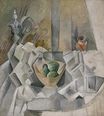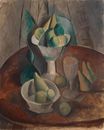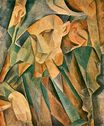©Pablo Picasso - Carafe, Jug and Fruit Bowl 1909
 |
 |
 |
 |
 |
 |
 |

Carafe, Jug and Fruit Bowl 1909
71x64cm oil/canvas
The Solomon R. Guggenheim Foundation
The image is only being used for informational and educational purposes
<< Previous G a l l e r y Next >>
From The Solomon R. Guggenheim Foundation:
Picasso’s still life Carafe, Jug, and Fruit Bowl, painted two summers before, shows an earlier stage of this style. Surfaces are broken into sharply defined planes but are not yet complexly fragmented; forms still retain an illusion of volume; and perspective, though dramatically shortened, is not obliterated. At its climax, Braque and Picasso brought Analytic Cubism almost to the point of complete abstraction. Among such works is Picasso’s Accordionist, a baffling composition that one of its former owners mistook for a landscape because of the inscription “Céret” on the reverse. With diligence, one can distinguish the general outlines of the seated accordionist, denoted by a series of shifting vertically aligned triangular planes, semicircular shapes, and right angles; the centrally located folds of the accordion and its keys; and, in the lower portion of the canvas, the volutes of an armchair. But Picasso’s elusive references to recognizable forms and objects cannot always be precisely identified and, as the Museum of Modern Art’s founding director Alfred H. Barr, Jr. observed, “the mysterious tension between painted image and ‘reality’ remains.”
Jan Avgikos